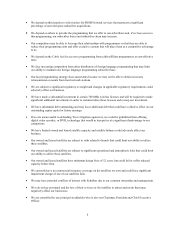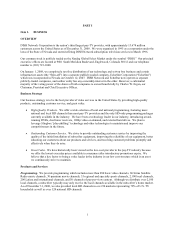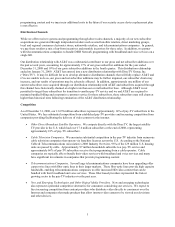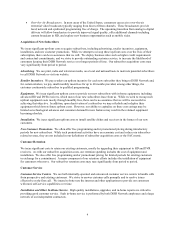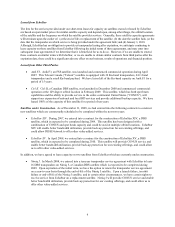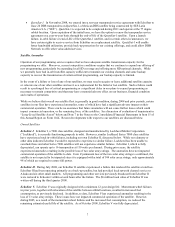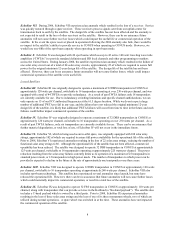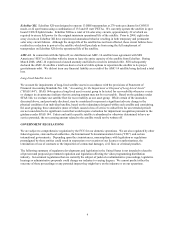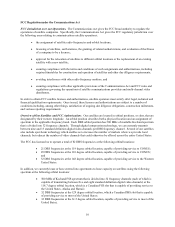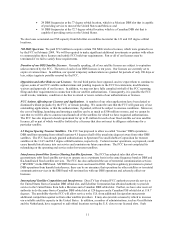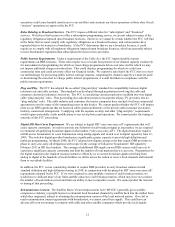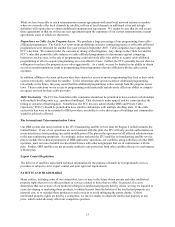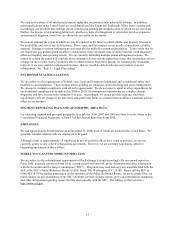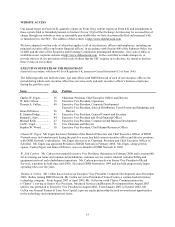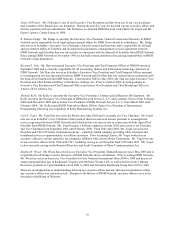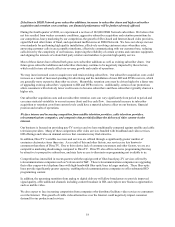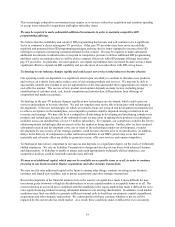Dish Network 2008 Annual Report Download - page 19
Download and view the complete annual report
Please find page 19 of the 2008 Dish Network annual report below. You can navigate through the pages in the report by either clicking on the pages listed below, or by using the keyword search tool below to find specific information within the annual report.9
EchoStar XII. EchoStar XII was designed to operate 13 DBS transponders at 270 watts per channel in CONUS
mode, or 22 spot beams using a combination of 135 and 65 watt TWTAs. We currently operate the satellite in spot
beam/CONUS hybrid mode. EchoStar XII has a total of 24 solar array circuits, approximately 22 of which are
required to assure full power for the original minimum operational life of the satellite. Prior to 2008, eight solar
array circuits on EchoStar XII have experienced anomalous behavior resulting in both temporary and permanent
solar array circuit failures. Although the design life of the satellite has not been affected, these circuit failures have
resulted in a reduction in power to the satellite which will preclude us from using the full complement of
transponders on EchoStar XII for the operational life of the satellite.
AMC-14. In connection with the Spin-off, we distributed our AMC-14 satellite lease agreement with SES
Americom (“SES”) to EchoStar with the intent to lease the entire capacity of the satellite from EchoStar. During
March 2008, AMC-14 experienced a launch anomaly and failed to reach its intended orbit. SES subsequently
declared the AMC-14 satellite a total loss due to a lack of viable options to reposition the satellite to its proper
geostationary orbit. We did not incur any financial liability as a result of the AMC-14 satellite being declared a total
loss.
Long-Lived Satellite Assets
We account for impairments of long-lived satellite assets in accordance with the provisions of Statement of
Financial Accounting Standards No. 144, “Accounting for the Impairment or Disposal of Long-Lived Assets”
(“SFAS 144”). SFAS 144 requires a long-lived asset or asset group to be tested for recoverability whenever events
or changes in circumstance indicate that its carrying amount may not be recoverable. Based on the guidance under
SFAS 144, we evaluate our satellite fleet for recoverability as one asset group. While certain of the anomalies
discussed above, and previously disclosed, may be considered to represent a significant adverse change in the
physical condition of an individual satellite, based on the redundancy designed within each satellite and considering
the asset grouping, these anomalies (none of which caused a loss of service to subscribers for an extended period)
are not considered to be significant events that would require evaluation for impairment recognition pursuant to the
guidance under SFAS 144. Unless and until a specific satellite is abandoned or otherwise determined to have no
service potential, the net carrying amount related to the satellite would not be written off.
GOVERNMENT REGULATIONS
We are subject to comprehensive regulation by the FCC for our domestic operations. We are also regulated by other
federal agencies, state and local authorities, the International Telecommunication Union (“ITU”) and certain
international governments. Depending upon the circumstances, noncompliance with legislation or regulations
promulgated by these entities could result in suspension or revocation of our licenses or authorizations, the
termination or loss of contracts or the imposition of contractual damages, civil fines or criminal penalties.
The following summary of regulatory developments and legislation in the United States is not intended to describe
all present and proposed government regulation and legislation affecting the video programming distribution
industry. Government regulations that are currently the subject of judicial or administrative proceedings, legislative
hearings or administrative proposals could change our industry to varying degrees. We cannot predict either the
outcome of these proceedings or any potential impact they might have on the industry or on our operations.


